HUMMER H3 2006 Owners Manual
Manufacturer: HUMMER, Model Year: 2006, Model line: H3, Model: HUMMER H3 2006Pages: 410, PDF Size: 2.61 MB
Page 131 of 410
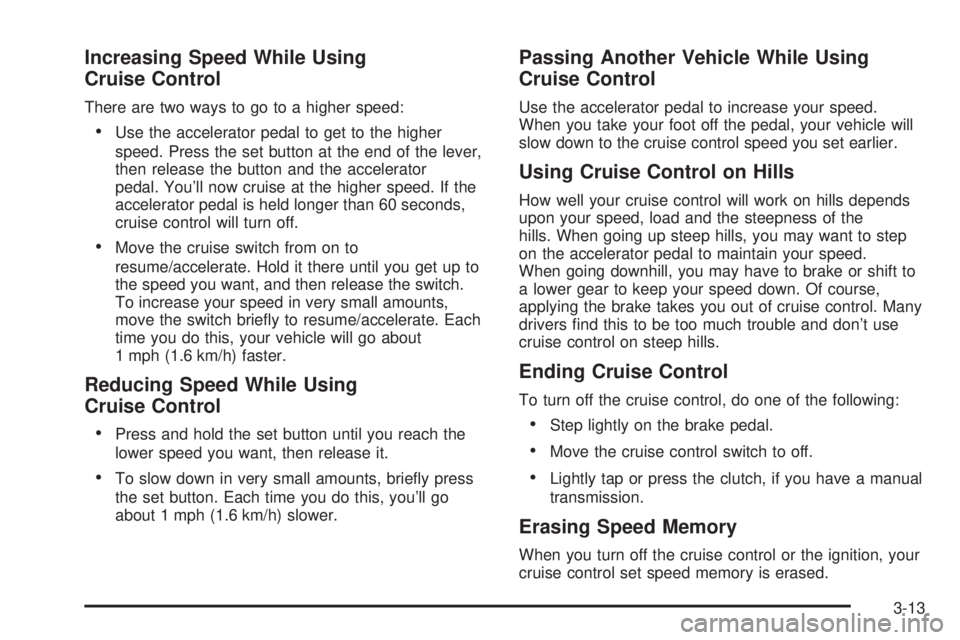
Increasing Speed While Using
Cruise Control
There are two ways to go to a higher speed:
Use the accelerator pedal to get to the higher
speed. Press the set button at the end of the lever,
then release the button and the accelerator
pedal. You’ll now cruise at the higher speed. If the
accelerator pedal is held longer than 60 seconds,
cruise control will turn off.
Move the cruise switch from on to
resume/accelerate. Hold it there until you get up to
the speed you want, and then release the switch.
To increase your speed in very small amounts,
move the switch brie�y to resume/accelerate. Each
time you do this, your vehicle will go about
1 mph (1.6 km/h) faster.
Reducing Speed While Using
Cruise Control
Press and hold the set button until you reach the
lower speed you want, then release it.
To slow down in very small amounts, brie�y press
the set button. Each time you do this, you’ll go
about 1 mph (1.6 km/h) slower.
Passing Another Vehicle While Using
Cruise Control
Use the accelerator pedal to increase your speed.
When you take your foot off the pedal, your vehicle will
slow down to the cruise control speed you set earlier.
Using Cruise Control on Hills
How well your cruise control will work on hills depends
upon your speed, load and the steepness of the
hills. When going up steep hills, you may want to step
on the accelerator pedal to maintain your speed.
When going downhill, you may have to brake or shift to
a lower gear to keep your speed down. Of course,
applying the brake takes you out of cruise control. Many
drivers �nd this to be too much trouble and don’t use
cruise control on steep hills.
Ending Cruise Control
To turn off the cruise control, do one of the following:
Step lightly on the brake pedal.
Move the cruise control switch to off.
Lightly tap or press the clutch, if you have a manual
transmission.
Erasing Speed Memory
When you turn off the cruise control or the ignition, your
cruise control set speed memory is erased.
3-13
Page 132 of 410
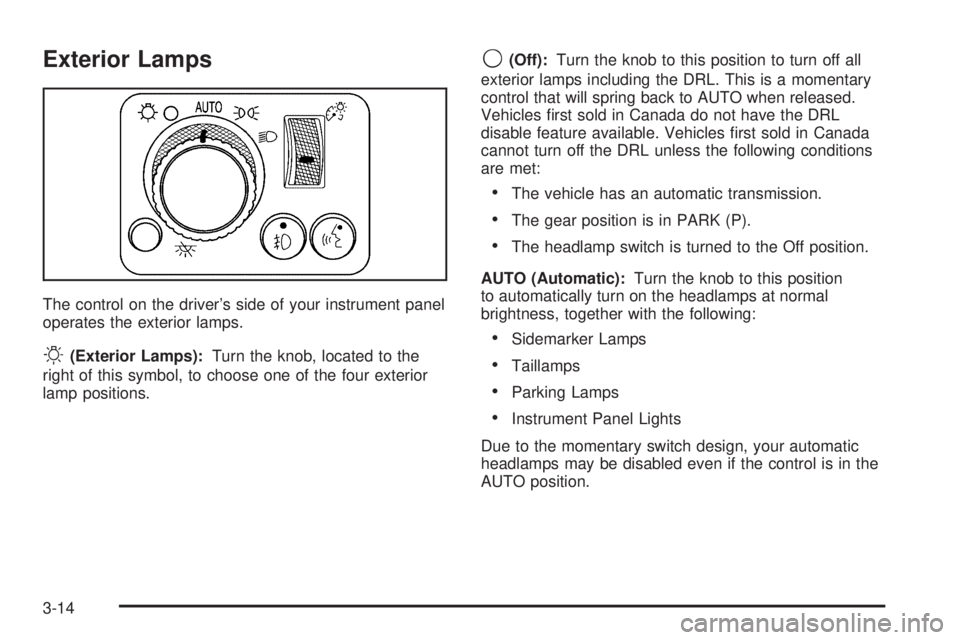
Exterior Lamps
The control on the driver’s side of your instrument panel
operates the exterior lamps.
O(Exterior Lamps):Turn the knob, located to the
right of this symbol, to choose one of the four exterior
lamp positions.
9(Off):Turn the knob to this position to turn off all
exterior lamps including the DRL. This is a momentary
control that will spring back to AUTO when released.
Vehicles �rst sold in Canada do not have the DRL
disable feature available. Vehicles �rst sold in Canada
cannot turn off the DRL unless the following conditions
are met:
The vehicle has an automatic transmission.
The gear position is in PARK (P).
The headlamp switch is turned to the Off position.
AUTO (Automatic):Turn the knob to this position
to automatically turn on the headlamps at normal
brightness, together with the following:
Sidemarker Lamps
Taillamps
Parking Lamps
Instrument Panel Lights
Due to the momentary switch design, your automatic
headlamps may be disabled even if the control is in the
AUTO position.
3-14
Page 133 of 410
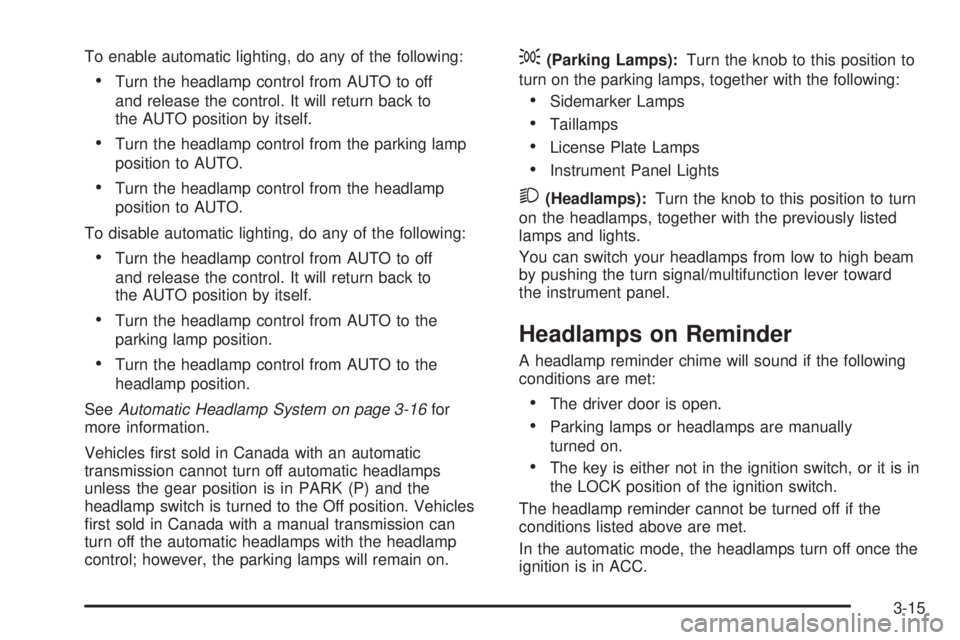
To enable automatic lighting, do any of the following:
Turn the headlamp control from AUTO to off
and release the control. It will return back to
the AUTO position by itself.
Turn the headlamp control from the parking lamp
position to AUTO.
Turn the headlamp control from the headlamp
position to AUTO.
To disable automatic lighting, do any of the following:
Turn the headlamp control from AUTO to off
and release the control. It will return back to
the AUTO position by itself.
Turn the headlamp control from AUTO to the
parking lamp position.
Turn the headlamp control from AUTO to the
headlamp position.
SeeAutomatic Headlamp System on page 3-16for
more information.
Vehicles �rst sold in Canada with an automatic
transmission cannot turn off automatic headlamps
unless the gear position is in PARK (P) and the
headlamp switch is turned to the Off position. Vehicles
�rst sold in Canada with a manual transmission can
turn off the automatic headlamps with the headlamp
control; however, the parking lamps will remain on.
;(Parking Lamps):Turn the knob to this position to
turn on the parking lamps, together with the following:
Sidemarker Lamps
Taillamps
License Plate Lamps
Instrument Panel Lights
2(Headlamps):Turn the knob to this position to turn
on the headlamps, together with the previously listed
lamps and lights.
You can switch your headlamps from low to high beam
by pushing the turn signal/multifunction lever toward
the instrument panel.
Headlamps on Reminder
A headlamp reminder chime will sound if the following
conditions are met:
The driver door is open.
Parking lamps or headlamps are manually
turned on.
The key is either not in the ignition switch, or it is in
the LOCK position of the ignition switch.
The headlamp reminder cannot be turned off if the
conditions listed above are met.
In the automatic mode, the headlamps turn off once the
ignition is in ACC.
3-15
Page 134 of 410
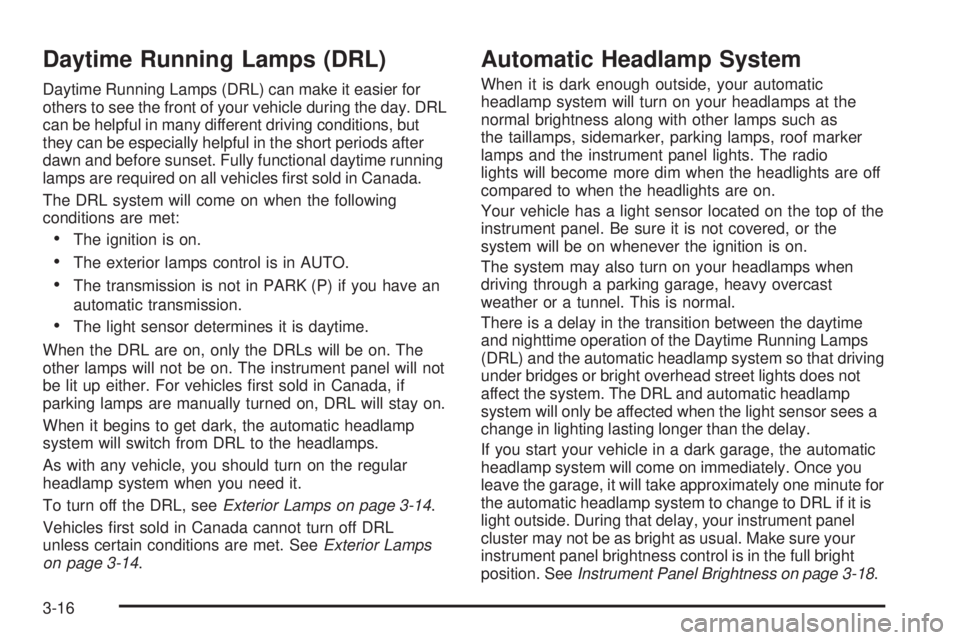
Daytime Running Lamps (DRL)
Daytime Running Lamps (DRL) can make it easier for
others to see the front of your vehicle during the day. DRL
can be helpful in many different driving conditions, but
they can be especially helpful in the short periods after
dawn and before sunset. Fully functional daytime running
lamps are required on all vehicles �rst sold in Canada.
The DRL system will come on when the following
conditions are met:
The ignition is on.
The exterior lamps control is in AUTO.
The transmission is not in PARK (P) if you have an
automatic transmission.
The light sensor determines it is daytime.
When the DRL are on, only the DRLs will be on. The
other lamps will not be on. The instrument panel will not
be lit up either. For vehicles �rst sold in Canada, if
parking lamps are manually turned on, DRL will stay on.
When it begins to get dark, the automatic headlamp
system will switch from DRL to the headlamps.
As with any vehicle, you should turn on the regular
headlamp system when you need it.
To turn off the DRL, seeExterior Lamps on page 3-14.
Vehicles �rst sold in Canada cannot turn off DRL
unless certain conditions are met. SeeExterior Lamps
on page 3-14.
Automatic Headlamp System
When it is dark enough outside, your automatic
headlamp system will turn on your headlamps at the
normal brightness along with other lamps such as
the taillamps, sidemarker, parking lamps, roof marker
lamps and the instrument panel lights. The radio
lights will become more dim when the headlights are off
compared to when the headlights are on.
Your vehicle has a light sensor located on the top of the
instrument panel. Be sure it is not covered, or the
system will be on whenever the ignition is on.
The system may also turn on your headlamps when
driving through a parking garage, heavy overcast
weather or a tunnel. This is normal.
There is a delay in the transition between the daytime
and nighttime operation of the Daytime Running Lamps
(DRL) and the automatic headlamp system so that driving
under bridges or bright overhead street lights does not
affect the system. The DRL and automatic headlamp
system will only be affected when the light sensor sees a
change in lighting lasting longer than the delay.
If you start your vehicle in a dark garage, the automatic
headlamp system will come on immediately. Once you
leave the garage, it will take approximately one minute for
the automatic headlamp system to change to DRL if it is
light outside. During that delay, your instrument panel
cluster may not be as bright as usual. Make sure your
instrument panel brightness control is in the full bright
position. SeeInstrument Panel Brightness on page 3-18.
3-16
Page 135 of 410
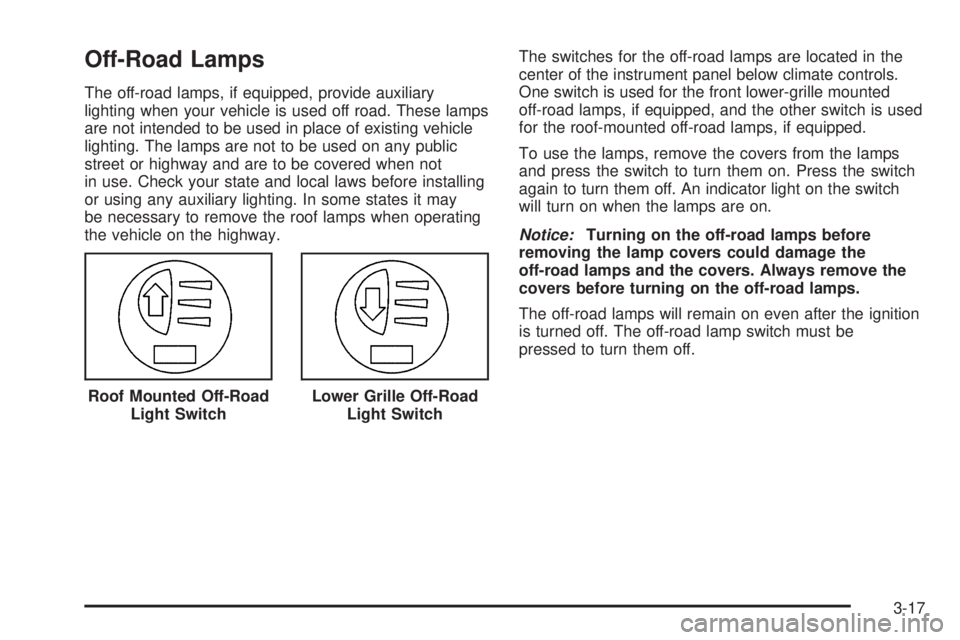
Off-Road Lamps
The off-road lamps, if equipped, provide auxiliary
lighting when your vehicle is used off road. These lamps
are not intended to be used in place of existing vehicle
lighting. The lamps are not to be used on any public
street or highway and are to be covered when not
in use. Check your state and local laws before installing
or using any auxiliary lighting. In some states it may
be necessary to remove the roof lamps when operating
the vehicle on the highway.The switches for the off-road lamps are located in the
center of the instrument panel below climate controls.
One switch is used for the front lower-grille mounted
off-road lamps, if equipped, and the other switch is used
for the roof-mounted off-road lamps, if equipped.
To use the lamps, remove the covers from the lamps
and press the switch to turn them on. Press the switch
again to turn them off. An indicator light on the switch
will turn on when the lamps are on.
Notice:Turning on the off-road lamps before
removing the lamp covers could damage the
off-road lamps and the covers. Always remove the
covers before turning on the off-road lamps.
The off-road lamps will remain on even after the ignition
is turned off. The off-road lamp switch must be
pressed to turn them off.
Roof Mounted Off-Road
Light Switch
Lower Grille Off-Road
Light Switch
3-17
Page 136 of 410
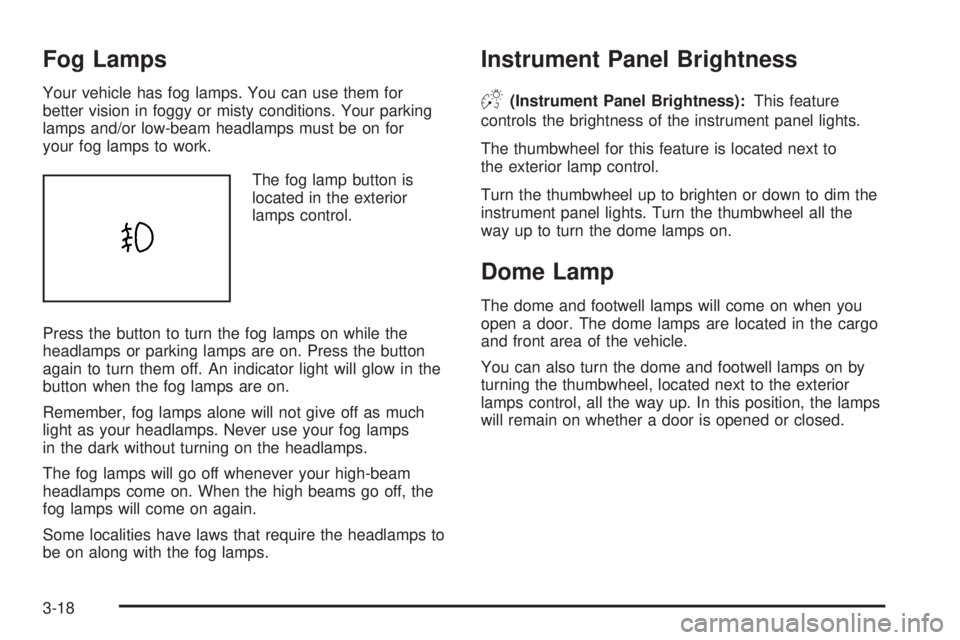
Fog Lamps
Your vehicle has fog lamps. You can use them for
better vision in foggy or misty conditions. Your parking
lamps and/or low-beam headlamps must be on for
your fog lamps to work.
The fog lamp button is
located in the exterior
lamps control.
Press the button to turn the fog lamps on while the
headlamps or parking lamps are on. Press the button
again to turn them off. An indicator light will glow in the
button when the fog lamps are on.
Remember, fog lamps alone will not give off as much
light as your headlamps. Never use your fog lamps
in the dark without turning on the headlamps.
The fog lamps will go off whenever your high-beam
headlamps come on. When the high beams go off, the
fog lamps will come on again.
Some localities have laws that require the headlamps to
be on along with the fog lamps.
Instrument Panel Brightness
D(Instrument Panel Brightness):This feature
controls the brightness of the instrument panel lights.
The thumbwheel for this feature is located next to
the exterior lamp control.
Turn the thumbwheel up to brighten or down to dim the
instrument panel lights. Turn the thumbwheel all the
way up to turn the dome lamps on.
Dome Lamp
The dome and footwell lamps will come on when you
open a door. The dome lamps are located in the cargo
and front area of the vehicle.
You can also turn the dome and footwell lamps on by
turning the thumbwheel, located next to the exterior
lamps control, all the way up. In this position, the lamps
will remain on whether a door is opened or closed.
3-18
Page 137 of 410
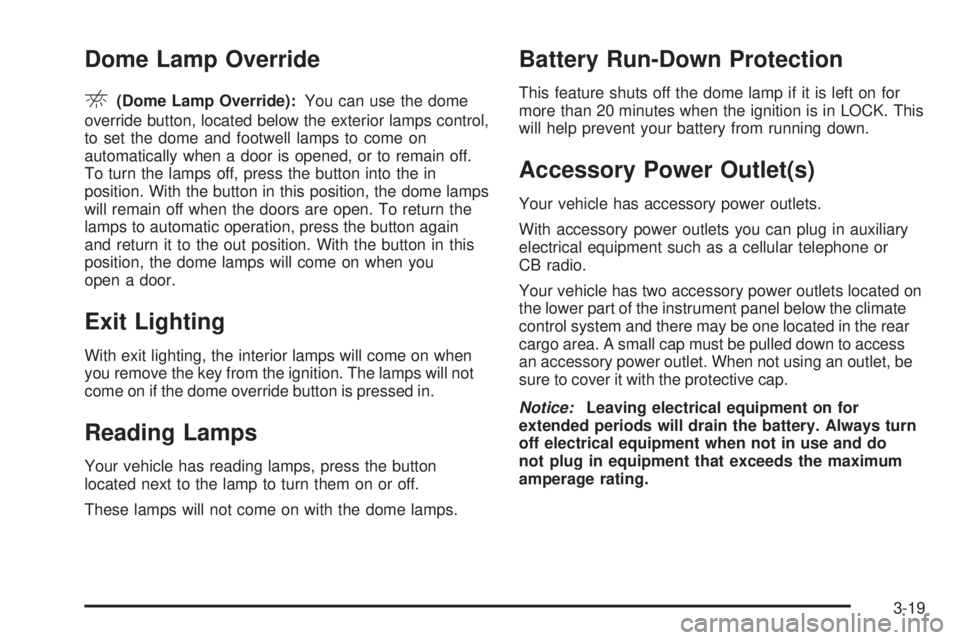
Dome Lamp Override
E(Dome Lamp Override):You can use the dome
override button, located below the exterior lamps control,
to set the dome and footwell lamps to come on
automatically when a door is opened, or to remain off.
To turn the lamps off, press the button into the in
position. With the button in this position, the dome lamps
will remain off when the doors are open. To return the
lamps to automatic operation, press the button again
and return it to the out position. With the button in this
position, the dome lamps will come on when you
open a door.
Exit Lighting
With exit lighting, the interior lamps will come on when
you remove the key from the ignition. The lamps will not
come on if the dome override button is pressed in.
Reading Lamps
Your vehicle has reading lamps, press the button
located next to the lamp to turn them on or off.
These lamps will not come on with the dome lamps.
Battery Run-Down Protection
This feature shuts off the dome lamp if it is left on for
more than 20 minutes when the ignition is in LOCK. This
will help prevent your battery from running down.
Accessory Power Outlet(s)
Your vehicle has accessory power outlets.
With accessory power outlets you can plug in auxiliary
electrical equipment such as a cellular telephone or
CB radio.
Your vehicle has two accessory power outlets located on
the lower part of the instrument panel below the climate
control system and there may be one located in the rear
cargo area. A small cap must be pulled down to access
an accessory power outlet. When not using an outlet, be
sure to cover it with the protective cap.
Notice:Leaving electrical equipment on for
extended periods will drain the battery. Always turn
off electrical equipment when not in use and do
not plug in equipment that exceeds the maximum
amperage rating.
3-19
Page 138 of 410
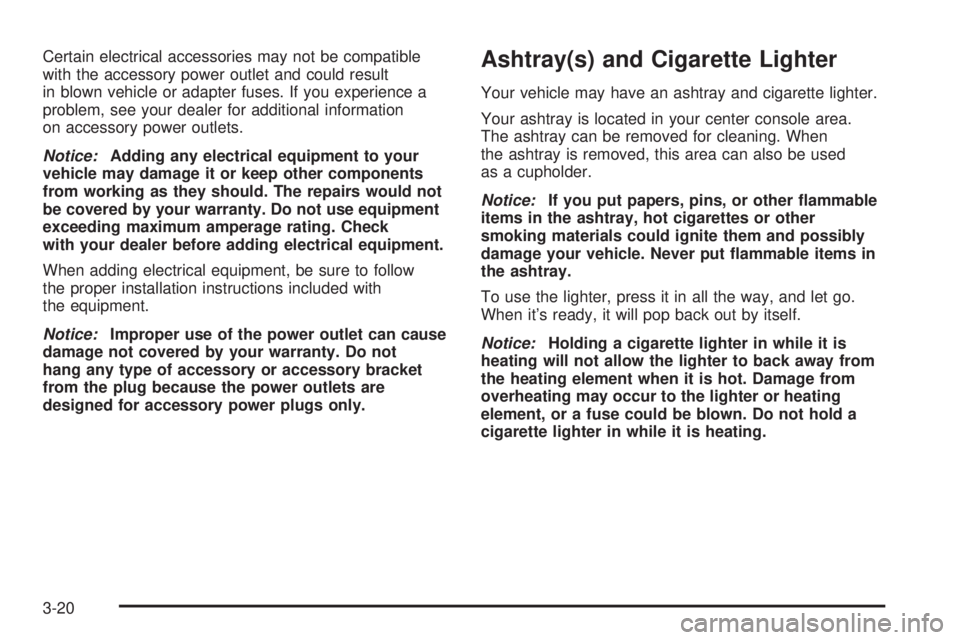
Certain electrical accessories may not be compatible
with the accessory power outlet and could result
in blown vehicle or adapter fuses. If you experience a
problem, see your dealer for additional information
on accessory power outlets.
Notice:Adding any electrical equipment to your
vehicle may damage it or keep other components
from working as they should. The repairs would not
be covered by your warranty. Do not use equipment
exceeding maximum amperage rating. Check
with your dealer before adding electrical equipment.
When adding electrical equipment, be sure to follow
the proper installation instructions included with
the equipment.
Notice:Improper use of the power outlet can cause
damage not covered by your warranty. Do not
hang any type of accessory or accessory bracket
from the plug because the power outlets are
designed for accessory power plugs only.Ashtray(s) and Cigarette Lighter
Your vehicle may have an ashtray and cigarette lighter.
Your ashtray is located in your center console area.
The ashtray can be removed for cleaning. When
the ashtray is removed, this area can also be used
as a cupholder.
Notice:If you put papers, pins, or other �ammable
items in the ashtray, hot cigarettes or other
smoking materials could ignite them and possibly
damage your vehicle. Never put �ammable items in
the ashtray.
To use the lighter, press it in all the way, and let go.
When it’s ready, it will pop back out by itself.
Notice:Holding a cigarette lighter in while it is
heating will not allow the lighter to back away from
the heating element when it is hot. Damage from
overheating may occur to the lighter or heating
element, or a fuse could be blown. Do not hold a
cigarette lighter in while it is heating.
3-20
Page 139 of 410

Climate Controls
Climate Control System
With this system you can control the heating, cooling,
and ventilation of your vehicle. In-between modes
are available by moving the right control knob between
modes with symbols. The in-between mode will be a
combination of the two modes that the control is
selected between.
Temperature:Turn the left knob on the control panel to
adjust the temperature of the air in the vehicle. Turn
the knob clockwise or counterclockwise to increase or
decrease the temperature.
#(Air Conditioning):Press the left knob on the
control panel to turn the air conditioning system on or
off. An indicator light on the button will come on to
let you know the air conditioning is activated. When the
system is on, this setting cools and dehumidi�es the
air entering your vehicle.
The air conditioning will not function if the fan is turned
off. If air conditioning is selected with fan off, the
indicator will �ash three times and then turn off.
You may notice a slight change in engine performance
when the air conditioning compressor shuts off and
turns on again. This is normal. The system is designed
to make adjustments to help with fuel economy while
still maintaining the selected temperature.
The air conditioning system removes moisture from the
air, so you may sometimes notice a small amount of
water dripping underneath your vehicle while idling
or after turning off the engine. This is normal.
9(Fan):Turn the center knob on the control panel to
control the fan speed. Turn the knob clockwise or
counterclockwise to increase or decrease the fan speed.
3-21
Page 140 of 410
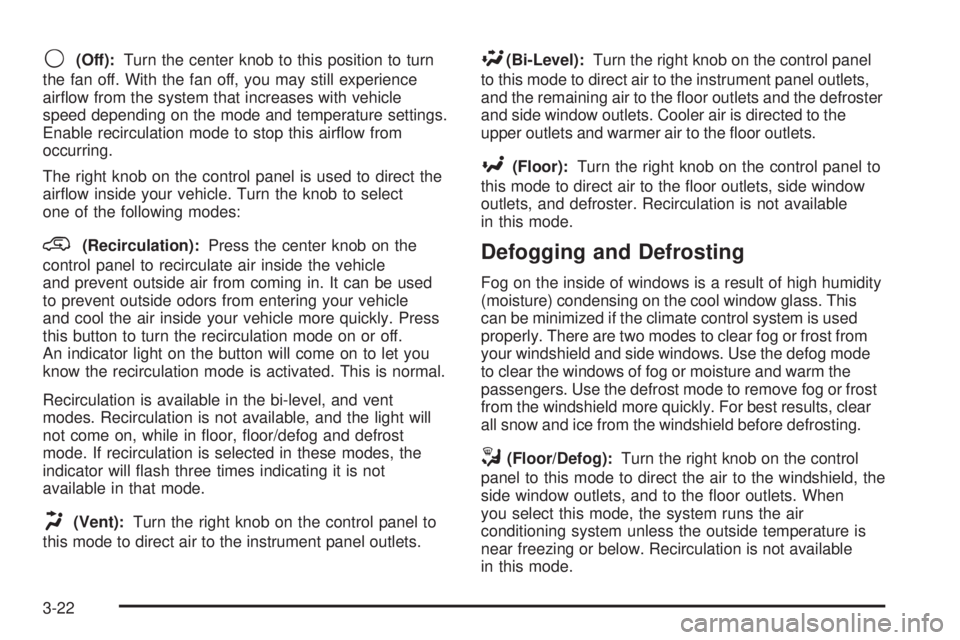
9(Off):Turn the center knob to this position to turn
the fan off. With the fan off, you may still experience
air�ow from the system that increases with vehicle
speed depending on the mode and temperature settings.
Enable recirculation mode to stop this air�ow from
occurring.
The right knob on the control panel is used to direct the
air�ow inside your vehicle. Turn the knob to select
one of the following modes:
@(Recirculation):Press the center knob on the
control panel to recirculate air inside the vehicle
and prevent outside air from coming in. It can be used
to prevent outside odors from entering your vehicle
and cool the air inside your vehicle more quickly. Press
this button to turn the recirculation mode on or off.
An indicator light on the button will come on to let you
know the recirculation mode is activated. This is normal.
Recirculation is available in the bi-level, and vent
modes. Recirculation is not available, and the light will
not come on, while in �oor, �oor/defog and defrost
mode. If recirculation is selected in these modes, the
indicator will �ash three times indicating it is not
available in that mode.
H(Vent):Turn the right knob on the control panel to
this mode to direct air to the instrument panel outlets.
\(Bi-Level):Turn the right knob on the control panel
to this mode to direct air to the instrument panel outlets,
and the remaining air to the �oor outlets and the defroster
and side window outlets. Cooler air is directed to the
upper outlets and warmer air to the �oor outlets.
[(Floor):Turn the right knob on the control panel to
this mode to direct air to the �oor outlets, side window
outlets, and defroster. Recirculation is not available
in this mode.
Defogging and Defrosting
Fog on the inside of windows is a result of high humidity
(moisture) condensing on the cool window glass. This
can be minimized if the climate control system is used
properly. There are two modes to clear fog or frost from
your windshield and side windows. Use the defog mode
to clear the windows of fog or moisture and warm the
passengers. Use the defrost mode to remove fog or frost
from the windshield more quickly. For best results, clear
all snow and ice from the windshield before defrosting.
/(Floor/Defog):Turn the right knob on the control
panel to this mode to direct the air to the windshield, the
side window outlets, and to the �oor outlets. When
you select this mode, the system runs the air
conditioning system unless the outside temperature is
near freezing or below. Recirculation is not available
in this mode.
3-22